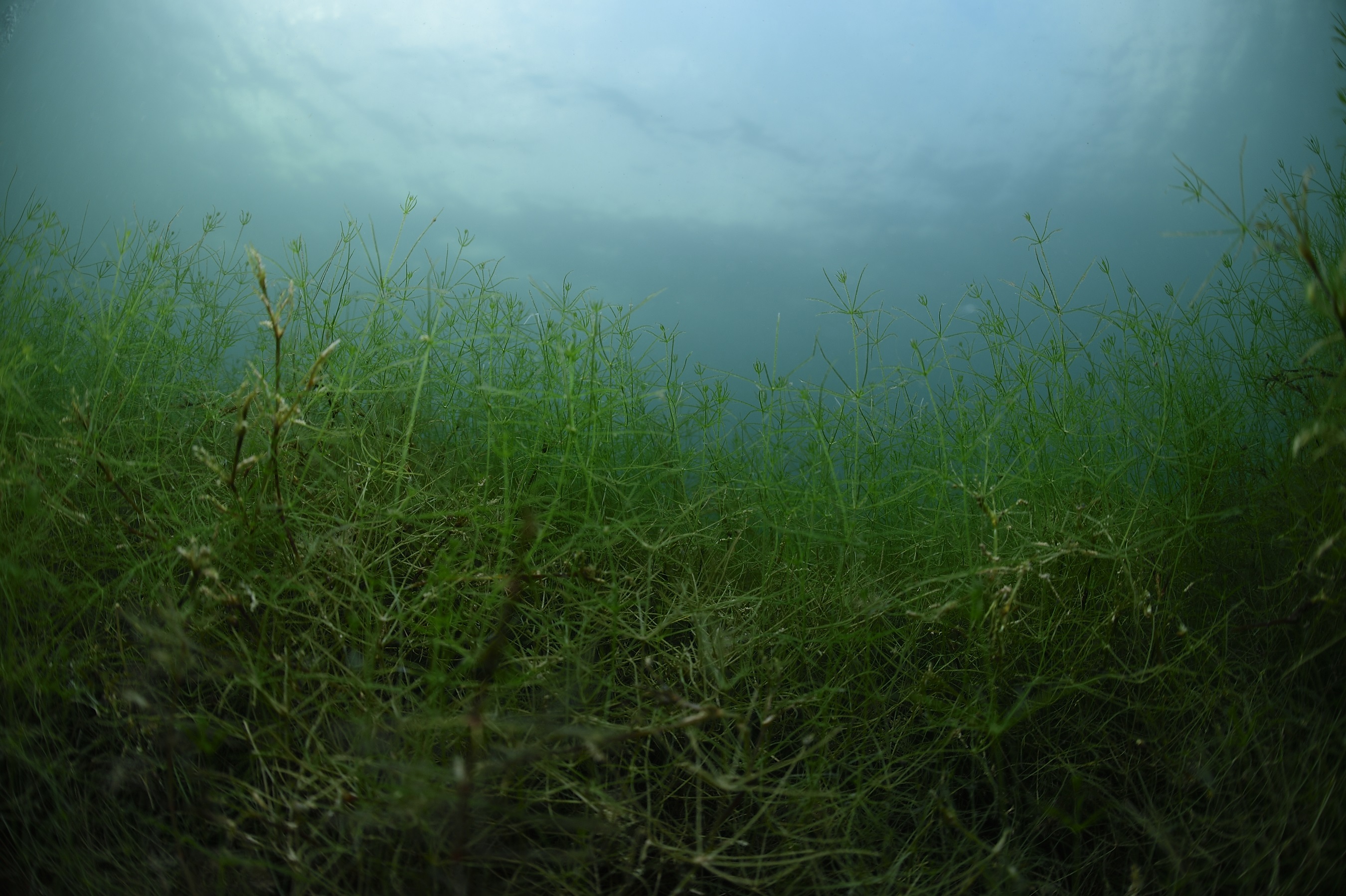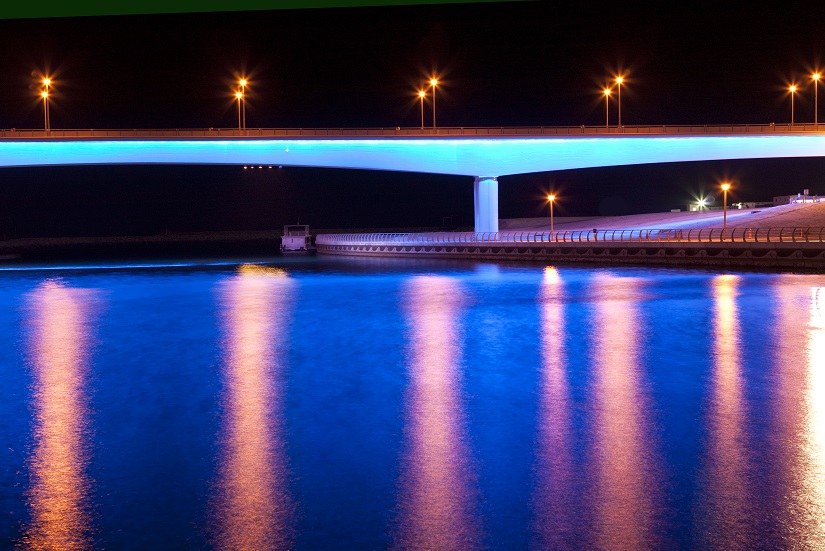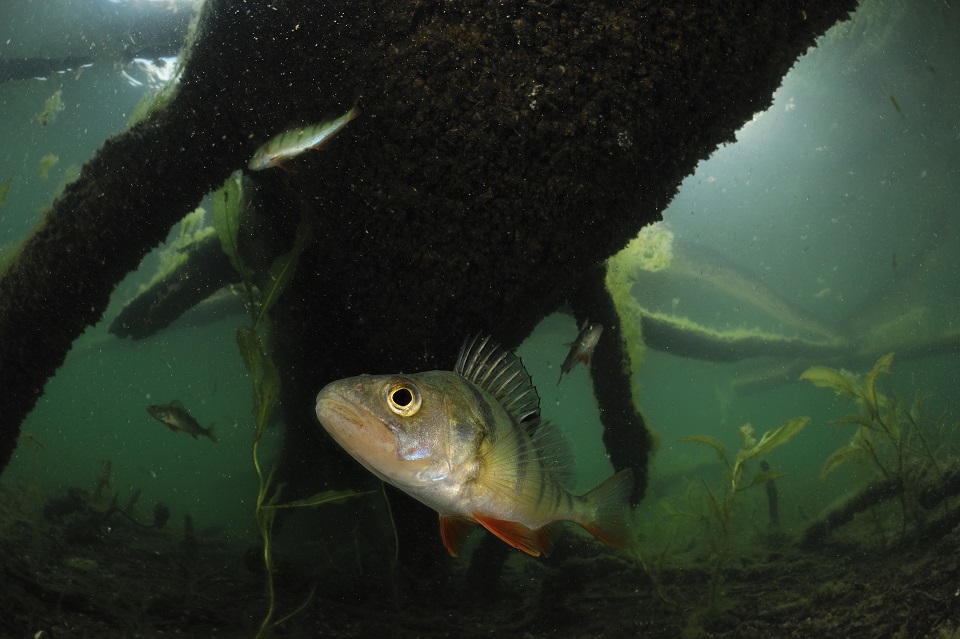
Only the moon: a lake without light pollution. | Photo: shutterstock_1821308687
More than half the world’s population lives within three kilometres of a freshwater body. As a result, human settlements and roads unintentionally excessively illuminate aquatic ecosystems at night.
Light behaves differently in air than in water
Until now, the effects of too much artificial light on human health and terrestrial species have been the main focus of light pollution research. Relating these findings to aquatic life is not straightforward, however, as the optical properties of water lead to marked differences in irradiance, spectral composition and polarisation patterns of light. “As a result, the physiological and behavioural adaptations of aquatic organisms to light differ from those of their terrestrial counterparts,” explained IGB researcher Franz Hölker, who leads a research group on light pollution and ecophysiology at IGB.

Photo: Solvin Zankl
What happens to light in water? Colour says it all
Clear water absorbs light, especially long-wave light in the red region of the electromagnetic spectrum, and scatters short-wave blue light. This is why ocean waters often appear blue.
However, dissolved and particulate substances influence the wavelength spectrum of light in most inland waters. Coloured dissolved organic matter such as humic substances, phytoplankton and other suspended particles transmit less light, especially at short wavelengths. The higher the concentration of humic substances, the greater the proportion of light at longer wavelengths (yellow and red light) in the water. Backscattered light usually dominates in the green region of the spectrum when algal abundances are sufficiently high, so that inland waters often appear green.
Some fish have a fourth colour receptor that is sensitive to UV light
Light serves as an energy source for organisms above and below the water surface – for example, for photosynthesis. It also determines biological rhythms and is essential for the transmission of visual information. There is rarely a plant that does noct orientate itself towards the sun, and only a few animals have no sense of sight.
Their photosensory systems range from single photoreceptor cells to complex camera-type eyes, some of them even capture polarisation patterns invisible to humans.
Aquatic organisms in deeper waters have astonishingly good vision, even in dim light. Freshwater prawns even have colour vision ability in moonlight. While humans can mainly see red, green and blue with their retinal cones, many fish (and birds, for that matter) also have a fourth colour receptor: they can see ultraviolet light. However, sensitivities to different wavelengths vary among habitats. Thus, fish inhabiting marine waters are often more sensitive to blue light than species inhabiting inland waters stained greenish-brownish by dissolved and particulate substances such as humic substances and algae. Examples include perch and roach. Spectral sensitivities can even change during life-history.
_web.jpg)
Photo: Dr Julian Taffner / Terra Aliens
Semi-aquatic insects undergo dramatic visual behaviour changes during life-history
Aquatic insects and anurans, in particular, which begin life in water then move to land as adults, experience dramatic changes in light conditions, e.g. irradiance, spectral distribution, and polarisation patterns.
They need to adapt their light perception capacities accordingly. Aquatic mayfly nymphs, for example, are mainly green-sensitive, whereas adults of this species tend to respond to short-wave light (blue, UV). “These examples are indicative of the strong selection pressure on vision adapted to an environment,” explained Franz Hölker.
Reflections on the water surface provide orientation for insects
Most aquatic insects such as beetles, water bugs, mayflies, chironomids and dragonflies can perceive polarised light and use this ability to locate suitable habitats and oviposition sites. In order to find appropriate sites, many of them orientate along the typical polarisation signatures of natural freshwaters created by reflections on water surfaces. Polarised light is created when the electromagnetic field of light only oscillates in one direction when it is refracted or reflected at the surface of water, for example, unlike direct sunlight, moonlight and the light from many artificial light sources.
.jpg)
Photo: Dr Julian Taffner / Terra Aliens
Light regulates the largest synchronised movement of biomass throughout the globe
The importance of light in the course of evolution has made it an important zeitgeber – even underwater. For example, the alternation of light and dark regulates one of the largest synchronised movements of biomass on our planet: the diel vertical migration of zooplankton and fish in the water column of marine and limnetic habitats. Many zooplankton species reside at low light levels in deep waters during the day to evade their visually hunting predators, moving to surface water layers only at night to feed on phytoplankton and microzooplankton. Despite the energetic cost of movement and the lack of food during the day, it seems to be worthwhile for these small organisms to seek a daytime refuge in deep waters. Planktivorous fish in lakes, such as whitefish (Coregonus spp.), follow the movements of their prey.
Daylight length indicates the seasons
Seasonal rhythms are also synchronised by natural light, especially by daylight length. These rhythms are particularly important for reproduction, including the spawning migration of many fish, the search for mating partners, spawning, and the development of fry. The decreasing day length in autumn is also important to allow organisms to prepare early for the challenging temperature, food and light conditions of winter.

Photo: shutterstock_67797310
Not all light is the same: differences between natural light and light pollution
Natural light incident on the Earth’s surface varies by many orders of magnitude between day and night depending on the position of the Sun, the Moon and stars, as well as on weather and atmospheric conditions. Horizontal illumination (measured in lux) is often used to measure this. It indicates the luminous flux emitted by a light source over a defined area of one square metre. For example, a normal candle flame produces about 1 lux at a distance of 1 metre. Our natural light on Earth ranges from daytime peaks exceeding 100,000 lux to 800 lux at sunset and a minimum of about 1 millilux on moonless nights.
Illuminance of light on inland waters 70 times higher than moonlight
Light pollution refers to the excessive, unnatural or disturbing illumination of the environment that has negative ecological consequences. There are two different forms: direct light pollution is radiation originating directly from public or, to some extent, private lighting such as street lights, illumination in buildings, vehicles, illuminated advertisements and architectural lighting. “Iluminance levels of up to 20 lux have been measured at the surface of inland waters, 70 times higher than the maximum irradiance of moonlight. Indirect light pollution is skyglow, which is readily recognised as a light dome above cities or industrial plants. Skyglow is caused by light radiating horizontally or upwards into the atmosphere, where it is diverted back to Earth, mainly as a result of scattering from water droplets and aerosols in the air”, explained Andreas Jechow. The light physicist worked for a long time in the research group on light pollution and is now Professor of Optics at Brandenburg University of Applied Sciences.
Clouds amplify skyglow, resulting in illuminance levels in excess of 1 lux in urban areas. This is many times brighter than the brightest moonlight.

Photo: Solvin Zankl
Consequences of light pollution on aquatic organisms, using fish as an example
Light pollution also has an impact underwater, at all levels of biodiversity, from individuals to ecosystems. For example, light pollution as low as 0.01 and 1 lux suppresses nocturnal melatonin production in perch and roach, respectively. Melatonin is the hormone that sets our internal clock. It tells us when we are tired or awake, for example.
Light pollution also affects sexual maturation in fish. Gonad development of many fish species in temperate climates is triggered by decreasing day lengths in autumn. If this signal is masked by artificial light during such a photo-labile period, the cue for gonad maturation is lost, as demonstrated for both perch and roach.
Light as a barrier: common toads migrate in red light
Direct light sources near water bodies can act as a barrier to animal movement in water and on land. Migratory fish, such as some young salmon and eels, occasionally interrupt their migration between the river and the sea at illuminated bridges and weirs. Bats, which use water courses as flyways and feeding habitats, are also distracted by bridge illumination. Migratory common toads avoid road sections illuminated with white or green – but not when the light is red.
%20Pixabay_web.jpg)
Photo: Pixabay_399407
Light attracts: vacuum cleaner effect of street lights close to water bodies
Over the course of evolution, many nocturnal insects have developed efficient sensors to detect light at low levels, enabling them to use starlight for orientation. This is why they are attracted to street lamps. Many illumination points act like “vacuum cleaners”, attracting insects from the surrounding area. This is problematic for aquatic insects such as mosquitoes and mayflies, which live as larvae in the water before coming on land as adults. Franz Hölker’s team studied the effects of artificial light sources on these hatching insects and showed that street lighting can act like a vacuum cleaner, sucking insect offspring out of the ecosystem along a strip of water about 100 metres long. As a result, these insects are unable to forage for food and attract mates as successfully as they do on naturally dark nights, and are no longer available as pollinators or food sources for other species.
Predator and prey: loss of refuge in the dark
“Over millions of years, predators have evolved sophisticated techniques to detect and capture prey, while prey species are constantly improving their defence strategies. Artificial light at night can shift the balance in this arms race,” remarked Franz Hölker.
Studies show, for example, that small predatory sculpins – a bony fish species – benefit from increased densities of sockeye fry attracted by artificial light. Likewise, predation risk for Chinook smolts increased significantly as light levels increased from 0 to 70 lux at the water surface.
Skyglow disrupts mass migration of zooplankton in the water column
In contrast to direct light sources, indirect light pollution – skyglow – hits the water surface from practically all angles above the horizon, resulting in a much larger fraction of the incident light penetrating the water. The diel vertical migration of zooplankton can be disrupted by even low illuminance levels, such as urban skyglow. This can also affect the densities and behaviour of fish and microalgae – which are closely linked to zooplankton via the food web.
Last but not least, artificial light has the potential to interact with other global change stressors, particularly in urban areas. Franz Hölker concluded: “In view of the range of demonstrated and potential impacts of light pollution on freshwaters, it is imperative to develop and apply effective lighting and light protection concepts. From a technical perspective, many measures are easy to implement. A critical prerequisite to alleviating the impacts of light pollution is to raise awareness among citizens and decision-makers of the problem of light pollution, and of the fact that policies and strategies have the potential to greatly improve the protection of freshwater ecosystems from light pollution without foregoing the benefits of nocturnal lighting for humans.”








